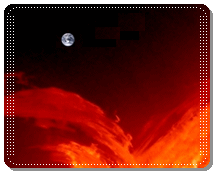
 Theory
Theory 
 Solar System to Scale
Solar System to Scale
| CONTENT - Get a sense of how planets in the solar system compare between themselves in terms of dimensions and distances to the Sun! |
| |
It is useful, as far as we Earthlings are concerned, that we have a sense of how planets of our solar system compare between themselves in terms of dimensions and distances to the Sun. The Earth is the third planet, a telluric one, in the system since the Sun
 | A view of how Earth looks small compared to the Sun! picture courtesy NASA/SDO |
First sketch (keeping planets' size right too however) puts solar system in perspective. It shows the faint character of terrestrial planets (Mercury (M), Venus (V), Earth (E), and Mars (M) -left, and Pluto (P) -far right, as the vastness of the solar system, especially when gas giants are concerned. Under each planet is its distance, in miles, from the Sun. Starting at Sun -far left- is quickly found the faint group of terrestrial planets: Mercury, Venus, Earth and Mars, all contained in 150 million miles. Following a gap is beginning the realm of gas giant planets: Jupiter, Saturn, Uranus, Neptune which are separated by vast amounts of distance: 400 million miles between Jupiter and Saturn, 900 million miles between Saturn and Uranus, 1 billion between Uranus and Neptune and the same distance between Neptune and Pluto
Second sketch (somehow keeping distances right) is showing planets and Sun relative sizes. It is displaying a nearly appropriate color for each planet. Sketch has been splitted for the region from Mercury to Mars ("M, V, E, M", bottom). Under each planet is given its diameter in miles. First to be noted is the importance of the Sun. It is about 800,000 miles in diameter, ten times vaster than the largest of the planets, Jupiter, and 100 times Earth's size. Once again, a split is found between the terrestrial planets (Mercury, Venus, the Earth, Mars, and Pluto), and gas giants. Two groups part into related sizes ranges. Earth and Venus are similar in size; Mercury is a little less than half Venus and Mars is about half the size of the Earth. Pluto is small: half size of Mercury. As far as gas giants are concerned, the largest of them is Jupiter, about 90,000 miles in diameter, more than 10 Earth's diameters. Saturn, the ringed planet, is a little smaller (about 75,000 miles). Uranus and Neptune, less than half of the previous, are similar in size (about 30,000 miles)
Website Manager: G. Guichard, site 'Amateur Astronomy,' http://stars5.6te.net. Page Editor: G. Guichard. last edited: 12/28/2010. contact us at ggwebsites@outlook.com


